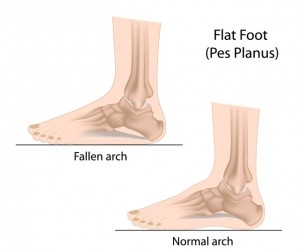Flat Foot
Stuart Katchis, M.D. is a leader in the treatment of flat foot and has more than 20 years of experience helping patients get back on their feet, pain-free.
Whether your condition has just recently developed and can be effectively treated with nonsurgical options, or it is more advanced and requires surgery, Extend Orthopedics will plan and implement a comprehensive treatment plan tailored to your unique condition.
What is flat foot?
Flat foot is a condition characterized by a partial or total collapse of the arch on the inside of the foot. It is a condition that can vary in severity and develop at different stages of life, from childhood to adulthood.
 What causes flat foot?
What causes flat foot?
Flat foot can be caused by a number of factors and, depending on age, it may be a perfectly normal condition that resolves itself with time. It is common to notice flat foot in young children because their arches have not yet developed. Arches typically develop during childhood as the tissues along the bottom of the feet tighten, but if you have a different foot structure you may never develop arches. In other cases, flat foot might occur due to an injury or as a result of wear and tear over time. When the tendons in the foot that support the arch are weakened, the arch can gradually fall.
What are the types of flat foot?
There are two distinct types of flat foot:
Flexible Flat Foot
Flexible flat foot describes the condition when a foot is still moveable and the arch typically reappears when no weight is being applied to the foot. This type of flat foot is common in children.
Rigid Flat Foot
Rigid flat foot describes the condition when a foot has become stiff and is fixed in a flat position even when no weight is being applied to it.
What are the symptoms of flat foot?
If you have flat foot, you may experience:
- A sole of the foot which entirely touches the ground when you stand
- Pain in the arch of the foot, heel, ankle or along the outside of the foot
- Swelling along the inside of the ankle
- Over-pronation of the ankle (the ankle appears to turn inward)
- Toe drift (the toes and front of the foot point outward)
- A tight Achilles tendon
- Bunions or hammertoes
- Pain in the shins, knees, hips or lower back
In some cases, you may have no painful symptoms at all and treatment is not necessary.
What are the risk factors for flat foot?
There are several factors that can increase your risk for flat foot:
- Age – the incidence of rigid flat foot increases as you get older
- Foot and ankle injuries – significant or repeated injuries to the foot or lower leg that damage tendons or ligaments, such as the posterior tibial tendon or Lisfranc joint complex, can lead to a flat foot deformity
- Physical conditions – certain physical conditions including tarsal coalition and obesity have been linked to the development of flat foot
- Family history – a family history of flat foot makes it more likely that you will have the abnormal foot structure as well
- Nerve damage – medical conditions or injuries that cause nerve damage in the feet, such as diabetes, place you at an increased risk for developing flat foot
- Inflammatory diseases – certain inflammatory diseases, such as rheumatoid arthritis, increase your risk for flat foot
What are the treatment options for flat foot?
If you are experiencing persistent pain or swelling around the arch or notice a progressive flattening of the arch, call our office at 212‑434‑4920 or fill out the schedule appointment form on this page so Stuart Katchis, M.D. can evaluate and diagnose your condition. Treatment for flat foot is only necessary if the condition is causing painful symptoms.
Nonsurgical Treatment
Nonsurgical treatment options may involve:
Using orthotics
Inserts placed in the shoes that raise and support the arches may considerably help to relieve pain and improve symptoms.
Altering footwear
Shoes with supportive soles should be worn at all times in lieu of sandals or shoes that offer minimal support.
Wearing a brace
A brace can provide extra support and stabilization for a foot with weakened ligaments in the arch.
Losing weight
Shedding extra pounds can reduce the pressure exerted on the feet and may improve flat foot symptoms.
Physical therapy
There are a number of stretches and strengthening exercises that may help improve flat foot symptoms, such as stretching the Achilles tendon. Dr. Katchis may recommend that patients see a physical therapist for treatment.
Surgical Treatment
Surgery may be required if nonsurgical treatments have not proven effective for improving symptoms and relieving pain. The type of surgical procedure recommended by Stuart Katchis, M.D. will depend upon each patient’s unique situation.
The overarching goal of performing flat foot surgery is to improve the alignment of the foot so that pressure is equalized and everyday movements like standing and walking are not painful. Sometimes multiple procedures are necessary to achieve optimal results for a patient. Types of surgery performed may include repairing, rerouting (transferring) or lengthening tendons that support the arch. Bone cuts or arthrodesis (fusion) procedures may be also required.
What does the recovery process entail?
Surgical treatment for flat foot involves several weeks or months of recovery depending on the type of surgery performed. With any type of surgery for this condition, it will require you to wear a cast to immobilize the foot while the ligaments and bones heal.
Whether you undergo nonsurgical or surgical treatment for flat foot, Dr. Katchis will provide recommendations for long-term measures designed to keep your symptoms from returning, such as footwear modifications and orthotics.




You must be logged in to post a comment.